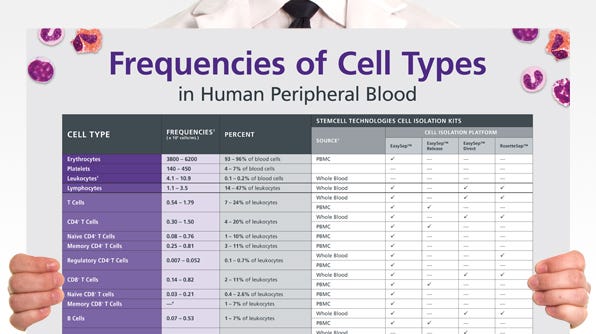Inflammatory and Autoimmune Diseases
Inflammatory and autoimmune diseases are often caused by genetic and environmental factors that give rise to aberrant immune responses. Controlling host immune responses without eliminating the ability to control infections is crucial to managing these diseases.
Below is a collection of scientific resources for your inflammatory and autoimmune disease research.
Frequencies of Cell Types in Human Peripheral Blood
This wallchart provides a list of the frequencies of cell types in human peripheral blood, as well as the column-free cell isolation kits available for each cell type.
Get Your Free Copy >-
 Transform Intracellular Delivery Using the CellPore‚Ñ¢ Transfection SystemIntracellular delivery of molecules is a key step in biological research, but traditional transfection methods are often limited in their ability to efficiently deliver macromolecules across diverse cell types without altering cell phenotype and function. <br><br>Watch this on-demand webinar‚Äîoriginally presented as a workshop at AAI 2025‚Äîto learn how the CellPore‚Ñ¢ Transfection System addresses these limitations by using mechanoporation to create transient membrane pores, enabling direct cytosolic delivery with high efficiency and cell viability.
Transform Intracellular Delivery Using the CellPore™ Transfection SystemIntracellular delivery of molecules is a key step in biological research, but traditional transfection methods are often limited in their ability to efficiently deliver macromolecules across diverse cell types without altering cell phenotype and function. <br><br>Watch this on-demand webinar—originally presented as a workshop at AAI 2025—to learn how the CellPore™ Transfection System addresses these limitations by using mechanoporation to create transient membrane pores, enabling direct cytosolic delivery with high efficiency and cell viability. -
 Production of Chimeric Antigen Receptor T CellsThis free Nature Protocols Wallchart summarizes the processes involved in producing CAR T cells for therapy.
Production of Chimeric Antigen Receptor T CellsThis free Nature Protocols Wallchart summarizes the processes involved in producing CAR T cells for therapy. -
 Frequencies of Human Cell Types in Blood-Related SourcesList of the frequencies of over 35 cell types in normal human blood-related sources.
Frequencies of Human Cell Types in Blood-Related SourcesList of the frequencies of over 35 cell types in normal human blood-related sources. -
 "The Mechanisms of Itch" Featuring Drs. Isaac Chiu and Tiphaine VoisinOn this episode of the Immunology Podcast, Drs. Isaac Chiu and Tiphaine Voisin discuss the role of the CysLT2R receptor in acute and chronic itch.
"The Mechanisms of Itch" Featuring Drs. Isaac Chiu and Tiphaine VoisinOn this episode of the Immunology Podcast, Drs. Isaac Chiu and Tiphaine Voisin discuss the role of the CysLT2R receptor in acute and chronic itch. -
 Tools for Optimizing Human Immune Cell ResearchObtaining consistent and reliable results when culturing immune cells can be challenging. Watch this webinar to discover how to obtain high yields of functional T cells, NK cells, B cells, dendritic cells, and macrophages for your research applications. The speaker, Evan Karas, also explains how to expand primary T cells without feeders or serum.
Tools for Optimizing Human Immune Cell ResearchObtaining consistent and reliable results when culturing immune cells can be challenging. Watch this webinar to discover how to obtain high yields of functional T cells, NK cells, B cells, dendritic cells, and macrophages for your research applications. The speaker, Evan Karas, also explains how to expand primary T cells without feeders or serum. -
 Thomas Krausgruber, PhDDr. Thomas Krausgruber discusses his research on understanding the complex relationship between our immune system and the intestinal microenvironment
Thomas Krausgruber, PhDDr. Thomas Krausgruber discusses his research on understanding the complex relationship between our immune system and the intestinal microenvironment -
 William Housley, PhDDr. William Housley describes his work studying the genetic basis of autoimmune diseases, including multiple sclerosis and Crohn's disease
William Housley, PhDDr. William Housley describes his work studying the genetic basis of autoimmune diseases, including multiple sclerosis and Crohn's disease -
 Kyle Burrows, BScKyle Burrows describes his work in the Zaph lab examining the molecular mechanisms that regulate CD4 + T cell subsets and innate lymphoid cells
Kyle Burrows, BScKyle Burrows describes his work in the Zaph lab examining the molecular mechanisms that regulate CD4 + T cell subsets and innate lymphoid cells





